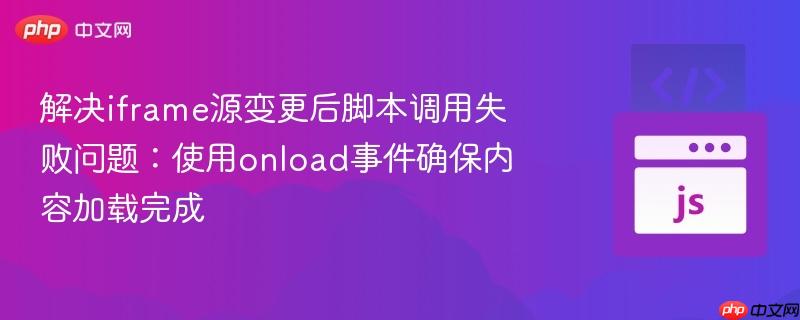
当iframe的src属性被修改后,立即尝试调用其contentWindow中的JavaScript函数会导致undefined错误。这是因为浏览器需要时间加载新的内容并执行其中的脚本。本教程将详细解释这一现象,并提供一种可靠的解决方案:通过监听iframe的onload事件,确保在新内容完全加载并准备就绪后,再进行脚本调用。
在Web开发中,iframe元素常用于在当前页面中嵌入另一个独立的HTML文档。父页面可以通过iframe.contentWindow访问其内部文档的全局对象,从而调用其中定义的函数或操作DOM。然而,这种交互并非总是即时可用的,尤其是在iframe的src属性发生变化时。
当您修改iframe.src时,浏览器会异步地加载新的HTML文档。这个过程包括网络请求、解析HTML、加载CSS和JavaScript等资源,并最终执行JavaScript代码。如果在新的文档完全加载并其内部脚本执行完毕之前,父页面就尝试通过contentWindow调用某个函数,那么该函数很可能尚未被定义或暴露在contentWindow上,从而导致undefined错误。
例如,考虑以下场景: 一个父页面包含一个iframe:
<iframe id="the-frame" name="the-frame" src="/index.html" sandbox="allow-same-origin allow-scripts allow-modals"></iframe>
/index.html中定义了一个简单的函数:
<html>
<body>
<script>
function printReport() {
alert('Hello from index.html');
}
</script>
</body>
</html>父页面通过以下方式调用该函数:
function viewReport(useV2) {
const iframe = document.getElementById("the-frame");
// 假设 /indexv2.html 也有 printReport() 函数
if (useV2) {
iframe.src = "/indexv2.html";
}
// 问题:如果 useV2 为 true,这里调用 printReport() 会失败
iframe.contentWindow.printReport();
}当useV2为true时,iframe.src被改变为/indexv2.html。但紧接着的iframe.contentWindow.printReport()调用会失败,因为浏览器尚未完成/indexv2.html的加载和脚本执行。
解决这个问题的关键在于,确保在父页面尝试与iframe新加载的内容交互之前,该内容已经完全加载并准备就绪。iframe元素提供了一个onload事件,它会在iframe内的文档及其所有依赖资源(包括图片、样式表和脚本)都加载完毕后触发。
通过将对iframe内部函数的调用逻辑放置在iframe的onload事件处理函数中,我们可以保证在脚本可用时才进行调用。
以下是修正后的viewReport函数示例:
/**
* 根据指定文件加载报表,并在加载完成后调用iframe内的printReport函数。
* 如果未指定文件,则直接调用当前iframe内容的printReport函数。
* @param {string} reportFile - 要加载的报表HTML文件路径,如果为null或undefined则不改变src。
*/
function viewReport(reportFile) {
const iframe = document.getElementById("the-frame");
if (reportFile) {
// 如果指定了新的报表文件,则改变iframe的src
iframe.src = reportFile;
// 绑定onload事件,确保在新内容加载完成后再执行操作
iframe.onload = function () {
// 在这里,iframe的新内容已完全加载,可以安全地调用其内部函数
if (iframe.contentWindow && typeof iframe.contentWindow.printReport === 'function') {
iframe.contentWindow.printReport();
} else {
console.warn('Iframe contentWindow或printReport函数未定义,请检查iframe内容。');
}
// 调用其他清理函数,例如关闭打印选项
closePrintOptions();
// (可选)为了防止重复触发,可以在执行后移除onload事件处理器
// iframe.onload = null;
};
} else {
// 如果没有指定新的报表文件,直接调用当前iframe的printReport函数
if (iframe.contentWindow && typeof iframe.contentWindow.printReport === 'function') {
iframe.contentWindow.printReport();
} else {
console.warn('Iframe contentWindow或printReport函数未定义,请检查iframe内容。');
}
closePrintOptions();
}
}
// 示例:假设存在一个关闭打印选项的函数
function closePrintOptions() {
console.log("关闭打印选项界面...");
}示例HTML结构(父页面):
<!DOCTYPE html>
<html lang="zh-CN">
<head>
<meta charset="UTF-8">
<title>Iframe交互教程</title>
</head>
<body>
<h1>Iframe内容加载与脚本调用</h1>
<iframe id="the-frame" name="the-frame" src="/index.html"
sandbox="allow-same-origin allow-scripts allow-modals"
style="width: 80%; height: 300px; border: 1px solid #ccc;"></iframe>
<p>
<button onclick="viewReport('/indexv2.html')">加载V2报表并打印</button>
<button onclick="viewReport(null)">打印当前报表</button>
</p>
<script>
// 上述 viewReport 和 closePrintOptions 函数代码放置在此处
/**
* 根据指定文件加载报表,并在加载完成后调用iframe内的printReport函数。
* 如果未指定文件,则直接调用当前iframe内容的printReport函数。
* @param {string} reportFile - 要加载的报表HTML文件路径,如果为null或undefined则不改变src。
*/
function viewReport(reportFile) {
const iframe = document.getElementById("the-frame");
if (reportFile) {
iframe.src = reportFile;
iframe.onload = function () {
if (iframe.contentWindow && typeof iframe.contentWindow.printReport === 'function') {
iframe.contentWindow.printReport();
} else {
console.warn('Iframe contentWindow或printReport函数未定义,请检查iframe内容。');
}
closePrintOptions();
// 移除onload处理器,避免在iframe内部发生其他加载时意外触发
iframe.onload = null;
};
} else {
if (iframe.contentWindow && typeof iframe.contentWindow.printReport === 'function') {
iframe.contentWindow.printReport();
} else {
console.warn('Iframe contentWindow或printReport函数未定义,请检查iframe内容。');
}
closePrintOptions();
}
}
function closePrintOptions() {
console.log("关闭打印选项界面...");
}
// 页面加载时,确保初始iframe内容加载完成
document.addEventListener('DOMContentLoaded', () => {
const iframe = document.getElementById("the-frame");
if (iframe.src) { // 如果iframe有初始src
iframe.onload = function() {
console.log("初始iframe内容加载完成.");
// 初始加载完成后可以执行一些操作,或者直接清除onload
iframe.onload = null;
};
}
});
</script>
</body>
</html>示例Iframe内容 (/index.html 或 /indexv2.html):
<!DOCTYPE html>
<html lang="zh-CN">
<head>
<meta charset="UTF-8">
<title>Iframe内容</title>
<style>
body { font-family: sans-serif; padding: 20px; background-color: #f0f0f0; }
h2 { color: #333; }
</style>
</head>
<body>
<h2>这是Iframe中的报表内容</h2>
<p>当前文件: <span id="filename"></span></p>
<script>
function printReport() {
const filename = window.location.pathname.split('/').pop();
alert('打印报表: ' + filename);
console.log('Iframe内部函数 printReport() 被调用。');
}
document.getElementById('filename').textContent = window.location.pathname.split('/').pop();
</script>
</body>
</html>当iframe的src属性被动态修改时,由于浏览器异步加载新内容的特性,父页面不能立即访问新iframe内容中的JavaScript函数。通过利用iframe的onload事件,我们可以确保在新的HTML文档及其所有脚本完全加载并准备就绪之后,才安全地进行跨帧的脚本调用。这种方法保证了代码的健壮性和可靠性,是处理此类iframe交互问题的标准实践。
以上就是解决iframe源变更后脚本调用失败问题:使用onload事件确保内容加载完成的详细内容,更多请关注php中文网其它相关文章!

每个人都需要一台速度更快、更稳定的 PC。随着时间的推移,垃圾文件、旧注册表数据和不必要的后台进程会占用资源并降低性能。幸运的是,许多工具可以让 Windows 保持平稳运行。

Copyright 2014-2025 https://www.php.cn/ All Rights Reserved | php.cn | 湘ICP备2023035733号